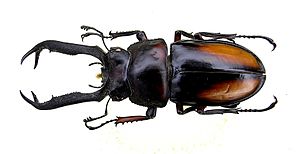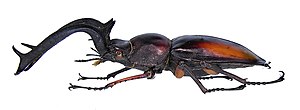Rhaetulus didieri
| Rhaetulus didieri | ||||||||||||
|---|---|---|---|---|---|---|---|---|---|---|---|---|

Rhaetulus didieri , male |
||||||||||||
| Systematics | ||||||||||||
|
||||||||||||
| Scientific name | ||||||||||||
| Rhaetulus didieri | ||||||||||||
| ( de Lisle , 1970) |
Rheatulus didieri is a beetle fromthe Schröter family . It occurs on the Malay Peninsula and was not scientifically described until 1970. It was made in honor of Dr. Robert Didier , who worked on stag beetles, named. The male can grow up to 85 millimeters and has bizarre "antlers", which the female lacks.
Description of the male
The head is significantly wider than it is long. The front corners are rounded. Behind the eyes, the head tapers at an angle of about 45 °. A horizontal chitin clasp (canthus) protrudes from the front into the eyes and reaches about the middle. The canthus runs parallel to the body axis and is cut off at right angles in front, without a spine. The chitin plate over the mouth (epistome) is clearly drawn out and is pointed at the front edge in the middle and at the corners. The ten-jointed antennae are kneeled, the flagellum joint remarkably slender and long. The last three antenna elements are widened like a fan on one side, the seventh antenna element in front has a spike-like extension on the same side.
The upper jaws (mandibles) form mighty antlers with slender and curved branches. Initially, the antlers arch upwards above head level, then they curve down and forward and run fairly straight and far forward. Each side ends in a fork that is aligned vertically, curved slightly inward and rounded in the shape of a U. In front of the highest point of the antlers sits a mighty tooth-shaped outgrowth on the outside, which is slightly curved upwards, backwards and inwards and tapers to a point. Outside, or above, the upper jaws are convexly arched, inside and below, concave. The edges between the convex and concave sides are finely serrated. On the upper tooth bar between the tooth-like outgrowth on the mandible base and the upper prong of the end fork, a tooth is significantly larger in the front third. The upper jaw is matt and very finely fluted (shagreen), the shagreen is finer than that of the head.
The pronotum is wider than it is long, arched, and widens backwards. The front corners are drawn down, the rear corner strongly rounded. The front edge is drawn forward in the middle, the rear edge curved imperceptibly and the side edge strongly serrated.
The elytra are narrower than the pronotum, elongated, arched and rounded in a semicircle at the back. A shoulder spine is indicated.
The legs are sturdy. The front splint ends in two strong teeth, in front of which there are some increasingly larger teeth on the outside. The middle rails have a long spike in the middle, the rear rails have a short tooth in the middle. There are pads of silky hair under the tarsi.
The head and pronotum are pitch black, only in exceptional cases there are dark red spots on the edge of the pronotum. The elytra are also pitch black, each with a red spot. This is stretched slightly diagonally towards the shoulders and the edges fade towards the back. With the exception of the legs, the underside is glossy, pitch black. The thighs are brightly orange on the upper and lower sides, turning brown towards the knee joint.
The male is elongated and resembles the smaller Rhaetulus speciosus boileaui , but differs significantly from it in the structure of the antler-like upper jaw and the coloration.
Description of the female
The females reach a length of 31 to 36 mm, the width varies between 12 and 13.5 millimeters. They are elongated, stocky and parallel. The top and bottom are glossy black with the exception of the thighs, which all have a dark orange stain on the top and bottom.
The head is roughly and converging punctured , towards the back the puncture is less dense and disappears on the back of the head. The chitin clasp (canthus) protruding into the eyes is straight and rounded. Like the male, it cuts the eyes out to about the middle.
The pronotum is roughly punctured laterally, but very fine and disappearing on the disc. The side edges are strongly fluted to notched, not serrated as in the male. The front corners of the pronotum are clearly drawn forward, the rear corners only indistinctly developed.
The elytra are dense and evenly punctured very finely, the puncture is hardly clearer to the outside.
The underside of the middle breast section (metasternum) is leathery with a few large spots on the sides. The end of the abdomen also has a dotted zone.
The front rails are slightly thickened and broadly grooved towards the end. On the side they have some large teeth that alternate with small teeth. The middle and rear rails show a strong thorn pointing backwards about halfway along their length.
The female looks less massive than the male. The yellow spots on the thighs distinguish it from the related species Rh. Crenatus and Rh. Speciosus , and also larger and slimmer. The spotting of the thighs also occurs in Pseudorhaetus sinicus , but there the elytra are as if painted black and without any dots.
biology
Little is known about biology. The animals are found in the foothills of the Cameron Highlands at the foot of trees by small watercourses.
relationship
Views on the phylogenetic relationships within the family are different and unclear. A Japanese genetic analysis places the genus Rhaetulus very close to the genus Prosopocoilus . Both are most closely related to the genus Dorcus , of which there are also representatives in Central Europe, for example the beam shredder . The species Rhaetulus didieri is very close to the species Rhaetulus speciosus and is sometimes regarded as a subspecies thereof . The subdivision of the genus goes hand in hand with different distribution areas. Rh. Speciosus speciosus is found in Thailand , Rh. Speciosus from. boileaui in Laos , Rh. speciosus. gardneri in Burma , Rh. didieri in Malaysia , Rh. crenatus in Taiwan and Rh. recticornis in the Amami Islands .
Web links
Individual evidence
- ^ De Lisle MO (1968) Diagnose d'un Rhaetulus Westwood nouveau CR Séances Soc. Phys. Hist. Nat. Genève NS 3: 134-135
- ^ De Lisle MO (1970) Deuxième note sur quelques Lucanidae nouveaux ou peu connus. Rev. Suisse Zool., 77 (1) pp. 93-95.
- ^ De Lisle MO (1974) Note sur deux coleoptères lucanides originaires de Malaisie. Nouv. Rev. Ent., IV (1) 51-54
- ^ Ratti P. (1972) Descrizione della femmina di Rhaetulus didieri De Lisle. Boll. Soc. Entom. Ital. pp 129-131
- ↑ Tadatsugu Hosoya, Kunio Araya: Phylogeny of Japanese Stag Beetles (Coleoptera: Lucanidae) . (pdf) In: Zoological Science . 22, 2005, pp. 1305-1318.
- ↑ MAES JM - Nota sobre Rhaetulus speciosus Boileau (Coleoptera: Lucanidae). Pp.7-12 1996 No 35: as PDF


